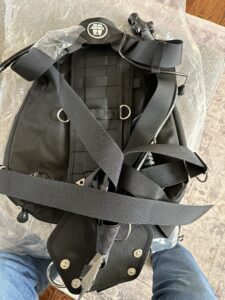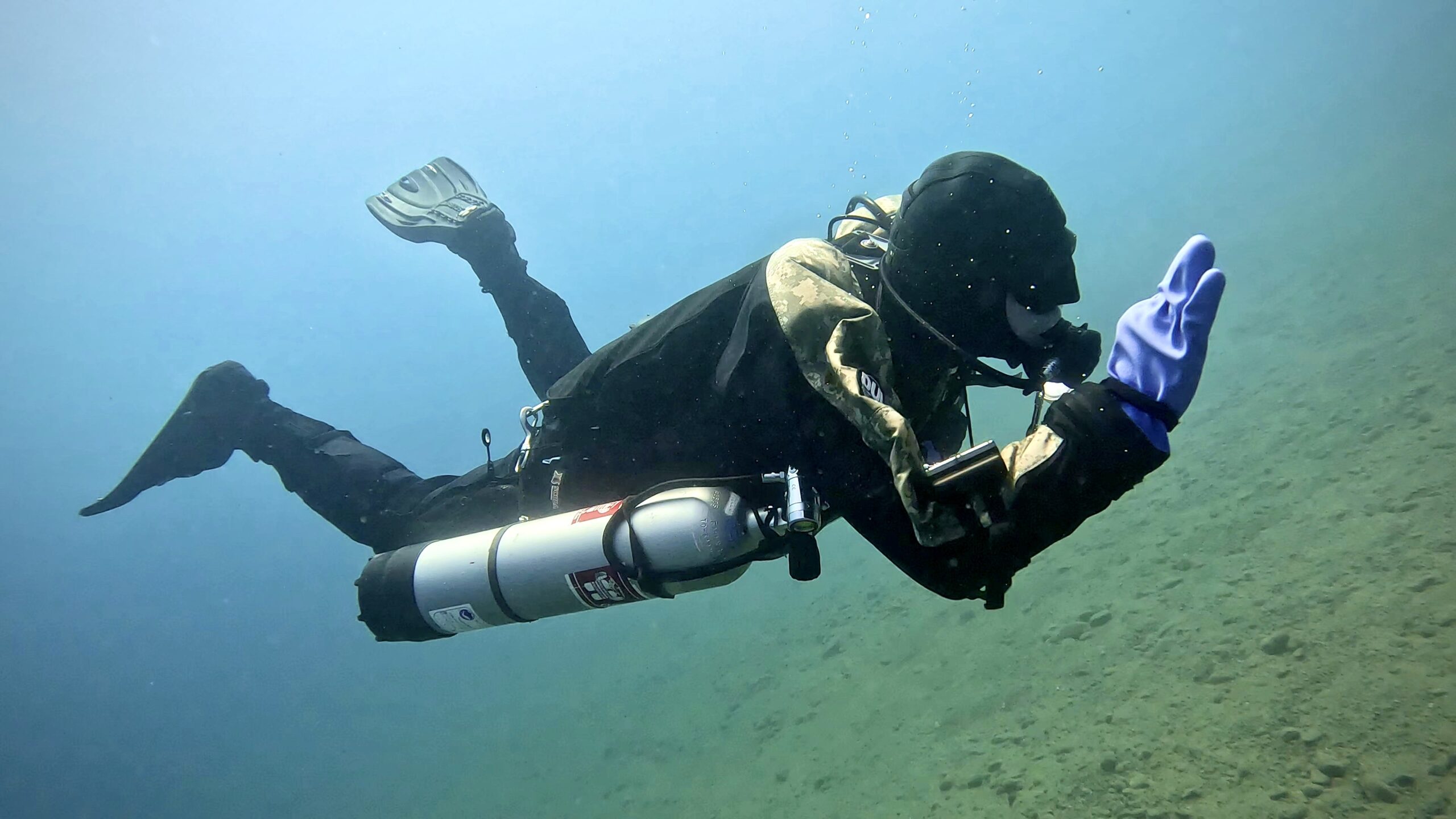OMS SideStream Sidemount Diving System
I started diving sidemount 8 or 9 years ago. At the time, it was really just something different to learn. I didn’t expect to do a lot of diving in sidemount configuration, since I was doing a lot of deep trimix dives at the time. These dives requires a fairly large volume of gas, which is generally better suited to diving in back mount doubles.
Since then, a number of things have changed. First, I discovered that sidemount is an awesome way to dive. Sidemount moves all your valves up front, making shutdowns a snap. More importantly, carrying tanks to the water individually is way easier on my back.
Also, you can travel with a sidemount system and conduct technical dives in locations where doubles are difficult or impossible to find. These days, I’ve even started leaving my single-tank, back mount gear at home on some trips.
On top of that, I’m only rarely doing deep dives on doubles. I have a handful of trimix dives coming up where I’ll be teaching, but other than that, I’d rather be on a rebreather, or adjust my dive plans to require less gas.
Travel Sidemount Systems (Warm Water)
Sidemount diving with aluminum 80s in warm water is great. They’re close to neutral and available everywhere. I built my travel sidemount system around a SubGravity Diamond 17lb wing. The whole thing—harness, wing, regulators and all—fits inside a large regulator bag.
I routinely conduct technical dives to 200’ all over the world, and still manage to travel lighter than with my single tank backplate and wing.
But, that system is not ideal for cold water. The biggest problem is providing enough lift at the surface and not being able to carry enough lead for a drysuit.
Sidemount Diving in Cold Water
Cold water sidemount demands more lead and more lift. Minimalist sidemount scuba systems tend to limit both. A problem for me is to meet training standards, instructors are required to carry redundant bladders.
To accomplish that, I have been diving with a Hollis SMS100 for years. It’s good, but bulky. The truth is, I can easily swim my cold water cylinders, plus a couple deco bottles to the surface, even if my wing were to fail. For teaching, my drysuit counts as redundant buoyancy. (In warm water, that’s not available…)
In any case, Hollis recently discontinued the SMS100, so it doesn’t matter much. The main point is most “cold water” sidemount scuba systems are anything but minimalist, and most totally suck in warm water.
Is There a Cold Water Minimalist Sidemount Scuba System?
 I set out to find out last Fall. I basically had enough of the SMS100 and had it in my mind to build a cold water version of the harness I configured for the SubGravity Diamond. They used to have a 27# lift version that I assumed would be perfect. The problem is it doesn’t seem to exist anymore.
I set out to find out last Fall. I basically had enough of the SMS100 and had it in my mind to build a cold water version of the harness I configured for the SubGravity Diamond. They used to have a 27# lift version that I assumed would be perfect. The problem is it doesn’t seem to exist anymore.
That led me to look at the Razor, Dive Rite Nomad Ray, X-Deep Stealth, Hollis Katana and any others I could find. Only the Razor had a redundant bladder system that made sense for this type of system. It uses a manual-inflate, redundant bladder that blows up like an SMB. It’s tiny, requires no extra hoses, and meets training standards.
The problem is that Razor is stupid-expensive. My configuration would be over $1,000. Come on! I dive rebreathers, so I am well aware that dive gear can be pricey. But, seriously, a grand for that? Ugh….
I almost pulled the trigger on it when I stumbled on some obscure reference to the OMS SideStream Harness (SKU: OM10301 https://www.divedui.com/collections/oms-dive-gear/products/SideStream-harness-27lb-redundant-air-cell-spine-weight-pocket?variant=34665043713). Out of the box, the entire OMS sidemount system retails for $359. The SideStream uses the same redundant bladder concept as the Razor, and includes a 15 pound weight system.
I had mine in hand in less than a week…
Adjusting the OMS SideStream Harness
The first thing I did was to sit down on the floor and start loosening straps and buckles, etc., so I could get the SideStream adjusted to my body when wearing a drysuit (also DUI) and Halo 3D undergarment.
It takes a little thought and patience to sort out how all the components fit together. The main webbing that runs up your spine continues on through the butt plate, so adjusting one end requires a corresponding adjustment somewhere else. With the weight system in place this is a bit of a trial and error effort.
The good news is once you get it right, you’re done until you replace your drysuit undergarments or get fat (or thin).
Overall, getting the SideStream set up and ready to dive is pretty easy after a little head-scratching. My main concern was going to be weighting…
Weighting with the OMS SideStream Harness
The SideStream comes with a weight pocket system that runs up your back. This is a fairly common weighting method for sidemount systems. It holds 15 pounds distributed in 3 individual pockets. They load from the side, so access is good.
The pockets are an independent unit that’s threaded into the harness. You could easily change it if there’s a system you like better, although I can’t think of many reasons why you would. One reason might be capacity. 15 pounds isn’t enough for cold water drysuit diving (more on that in a minute). Also, some divers might find that the placement puts a strain on their back.
Diving with the OMS SideStream Harness
My first dive with the SideStream sidemount systems was tagging along during a tech diving course with another instructor. It was a shallow, skill assessment dive, so I had lots of time to get a feel for trim, hose routing, dump and inflator placement, etc.
My primary concern was weighting. My go-to sidemount cylinders are Faber LP50’s. They are very slightly negative when full, and almost dead-neutral with the valves when empty. Being just 5 1/2 inches in diameter, they are about as perfect as it gets for sidemount diving.
In my Hollis SMS100, I used 22 pounds in a weight plate, so 15 pounds would be light for sure. On the other hand, I’ve been feeling slightly overweighted, so I knew I had some leeway. To find out, I clipped a 2 pound weight to each waist d-ring, bringing the total to 19 pounds.
As it turned out 19 pounds was barely enough. The good news was I didn’t have to march back to my truck to get another clip-on. The bad news was I had to figure out the best way to get more weight into the rig without sacrificing its minimalist profile.
Since then, I have added two Dive Rite ditch-able weight pockets to the webbing, between the wing and each waist d-ring. The wing itself is very low profile, so the pockets tuck in without forcing me to change the d-ring location. 3 pounds in each pocket is perfect, so I ended up with 21 pounds instead of my previous 22. You wouldn’t think a pound would make much difference, but I can definitely feel it.
Trim with the OMS SideStream Harness
I really didn’t want to use waist pockets for my sidemount system. My greatest fear was that positioning weight down low would cause a feet-down diving position. In the water, it turned out to be a non-issue. Given that the pockets don’t interfere with my d-rings or trim, these may be the most elegant solution.
From the very first descent, my trim with the OMS SideStream has been perfect. I maxed the built-in pockets with 15 pounds and added the rest as described. I’m 5’9” and pretty lean, so I can say confidently, anyone with similar proportions using a drysuit will likely find it easy to achieve perfect trim.
I honestly believe anyone with a reasonable understanding of buoyancy control and moderate diving skills will find perfect trim, regardless of his or her height and weight. The only caveat being individuals requiring more than about 25 pounds of lead. That said, if you do need more lead, you’ll also need more than the available 27 pounds of lift. Those individuals are better off with a sidemount system like the Nomad.
Observations from Diving with the OMS SideStream
Now that I have a number of dives under my belt, here are my thoughts. As mentioned, house routing is trouble free. Once in the water, I find the toggle for the top dump to be difficult to feel while wearing dry gloves. Partly, this is due to added clutter from the backup inflator.
In my configuration, this doesn’t pose a problem, since I only use it once to begin my descent. After that, I’m able to control my buoyancy entirely by maintaining the volume of my drysuit. Even so, most divers will use the bottom dump during the dive. Add to that, I have built up some motor memory and most often find the toggle instinctively.
I find the manual (backup) inflator a little fidgety when wearing a drysuit, and dry gloves. However, in practice, I’ve had no issues inflating it. My recommendation is to practice until it becomes second nature. It won’t take long.
I added a few small bungee loops to the left shoulder strap to position the backup inflator hose and keep the routing consistent. It’s a little more tidy and makes the inflator more accessible when wearing gloves.
I was originally somewhat concerned about the weight pocket position causing back strain. In the water, I don’t feel it at all. One thing to keep in mind, is none of that weight is ditch-able. This is a reality for many technical diving situations, but I don’t recommend it for recreational divers.
Please get proper training before diving any sidemount scuba system. If you live anywhere near Reno or Lake Tahoe, you can arrange training with me.
The build quality of the OMS SideStream is really good, and I still can’t get over the price. If you are thinking about a minimalist sidemount system for diving in colder water, I absolutely recommend it. That said, nothing about the SideStream should prevent you from diving in warm water. It is a very compact rig and will travel very well.
If you own the OMS SideStream, or if you have questions, I’d love to hear from you!



Looking good Joe! Another one of the divers from Sierra just got his OMS sidestream.
With any luck we will see you in the water. 😀
Yeah, I’ll definitely be getting in the water. That OMS Sidestream is awesome. I’m available to run to the shop if anyone wants input setting it up.